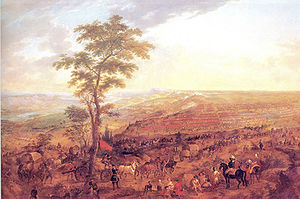Battle of Almenar
| date | July 26 , 1710 |
|---|---|
| place | Almenar , Spain |
| output | Allied victory |
| Parties to the conflict | |
|---|---|
| Commander | |
| Troop strength | |
| 44 battalions of infantry , 60 squadrons of cavalry , a total of 22,000 men | 35 infantry battalions, 52 cavalry squadrons, a total of 24,000 men |
| losses | |
|
1,500 men dead or wounded, 300 men captured |
400 men dead or wounded |
Carpi - Chiari - Cremona - Kaiserswerth - Luzzara - Cádiz - Friedlingen - Vigo - Schmidmühlen - Ekeren - Höchstädt (1703) - Gibraltar - Speyerbach - Schellenberg - Bonn - Höchstädt (1704) - Vélez-Málaga - Cassano - Barcelona (1705) - Sendlinger Murder Christmas - Calcinato - Ramillies - Turin - Castiglione - Almansa - Toulon - Lille - Oudenaarde - Malplaquet - Almenara - Saragossa - Brihuega - Villaviciosa - Denain - Rio de Janeiro - Barcelona
The Battle of Almenar (in Spanish Batalla de Almenar , in Catalan Batalla d'Almenar ) took place on July 27, 1710 during the War of the Spanish Succession near the municipality of Almenar in what is now the province of Lleida . The allied English and imperial forces on the one hand and the Spanish troops of Philip V on the other faced each other. The battle ended in an Allied victory.
prehistory
In order to demonstrate his readiness for peace, Louis XIV had largely withdrawn the French troops from the Spanish theater of war. Thereupon the military situation worsened for Philip V. Against his troops the allies under the command of Guido von Starhemberg and Stanhope could gain ground.
Both armies faced each other largely inactive since June 1710 at Lleida . On either side, the two candidates for the throne were with their troops. Both armies suffered from food shortages and disease spread. On July 25, the allies received strong reinforcements from Italy. The balance of power between the two sides was thus largely balanced. Stanhope had long been pressing for an attack, and Karl and Starhemberg have now given in. The project was made easier because the opponents had broken up their camp to march west.
course
Stanhope set out with a vanguard of a thousand Imperial grenadiers and 800 English and Dutch cavalrymen on July 26th, crossing the Segre River and the Noguera on the 27th . On the Spanish side, General Medici, Duke of Sarno, had been sent with the cavalry to occupy the banks of the Noguera, but did not get there until Stanhope.
Although outnumbered than Stanhope's troops, Medici did not attack, but instead posted his troops near Almera. In the course of the day Philip's main army joined them. The cavalry was posted on the heights. The infantry was set up in a cut in the ground.
Stanhope pushed for an offensive approach again, but Starhemberg persuaded him to wait until the main army had crossed the river. The deployment was not completed until around six o'clock in the evening, and it was only now that Stanhope was given permission to attack.
This attacked with 15 squadrons of cavalry supported by some artillery the 40 opposing squadrons and some battalions of infantry. The first Spanish meeting soon turned to escape, dragging the second meeting with it. The Spanish cavalry was defeated and dispersed. There was also confusion among the Spanish infantry without this having had combat contact with the Allied infantry under Starhemberg. Because of the falling darkness the fighting had to be stopped.
consequences
Philip was able to withdraw to Lerida with the Spanish infantry. The morale of the Spaniards suffered from the defeat and Philip distrusted his commanders. The Allies then marched on Saragossa and caused a heavy defeat for the Spaniards there .
Individual evidence
- ↑ used here: Gaston Bodart: Military-historical War Lexicon (1618-1905) . Vienna 1908, p. 162.
literature
- Manual for Army and Fleet. Encyclopedia of Martial Sciences and Allied Fields. Volume 9. Berlin a. a. 1912, p. 414.
- Landau Marcus: History of Emperor Charles VI. as King of Spain. Stuttgart 1889, pp. 563-565.
